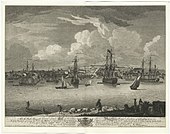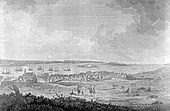HMS Prince of Orange (1734)
 A General View of Quebec, from Point Levy in 1759, by Richard Short
| |
| History | |
|---|---|
| Name | HMS Prince of Orange |
| Ordered | 5 May 1729 |
| Builder | Deptford Dockyard |
| Launched | 5 September 1734 |
| Fate | Sold, 1810 |
| General characteristics [1] | |
| Class and type | 1719 Establishment 70-gun third rate ship of the line |
| Tons burthen | 1128 |
| Length | 151 ft (46 m) (gundeck) |
| Beam | 41 ft 6 in (12.65 m) |
| Depth of hold | 17 ft 4 in (5.28 m) |
| Propulsion | Sails |
| Sail plan | Full-rigged ship |
| Armament |
|
HMS Prince of Orange was a 70-gun third rate ship of the line of the Royal Navy, built by Richard Stacey to the 1719 Establishment at Deptford Dockyard, and launched on 5 September 1734.[1]
In 1748, Prince of Orange was cut down to a 60-gun ship, a role in which it remained until being converted into a sheer hulk in 1772.[1] The Prince of Orange was part of the British Fleet at the capture of Louisbourg in 1758.
David Ramsay, fur trader, revolutionary War soldier, and Indian-killer was a crew member of Prince of Orange at both the Battle of Louisbourg in 1758 and the battle of Quebec in 1759. She brought Richard Short, the military artist to Quebec in 1759, where he drew pictures of the fleet, unfortunately not naming any vessel in particular.[2] He served as purser on her from 1759 to 1761,[3] within that period the ship was in Halifax, Nova Scotia, and Quebec City.
After nearly 40 years service as a hulk, she was finally sold out of the navy in 1810.[1]
Gallery of the fleet at anchor in Halifax, 1759, from sketches by Richard Short
[edit]-
Halifax, viewed from Dartmouth
-
Looking down Prince Street
-
The Town and harbour as it appears from George's Island
-
Looking down George Street
References
[edit]- ^ a b c d Lavery, Ships of the Line vol.1, p169.
- ^
"Richard Short". Dictionary of Canadian Biography. Retrieved 11 October 2018.
Nothing is known of Richard Short's naval career except the vessels in which he served: Baltimore (a sloop), Peregrine (a sloop built in 1749), Mermaid (a frigate, which he appears to have left before she sailed for Nova Scotia in 1754), Gibraltar (a frigate), and four ships of the line, Leopard (built in 1756), Prince of Orange, Dublin (which returned from the West Indies in 1763), and Neptune. After this service at sea he was appointed to the Chatham dockyard, England. Though the list of ships does not indicate extensive service for Short in North America, the Prince of Orange brought him there in the fleet accompanying Wolfe's forces in 1759.
- ^ Tuck, Robert (2008). Churches of Nova Scotia. Dundum. p. 155. ISBN 978-1550024784. Retrieved 26 April 2019.
sketches (made) by Richard Short, purser on HMS Prince of Orange 1756-61, using a camera obscura. These sketches were used by Dominique Serres to create paintings of Halifax.
- Lavery, Brian (2003) The Ship of the Line – Volume 1: The development of the battlefleet 1650-1850. Conway Maritime Press. ISBN 0-85177-252-8.




